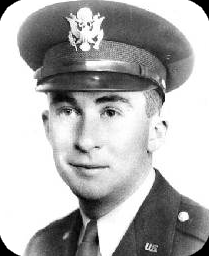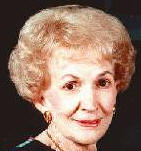 He
served in the military during World War II,
entering service as a private and leaving as
a captain. For two years, his duties
involved guarding the Panama Canal.
He
served in the military during World War II,
entering service as a private and leaving as
a captain. For two years, his duties
involved guarding the Panama Canal.Photo: May 16, 1945: Edward L. Gaylord is a "brand new flying cadet" in the U.S. Army Air Corps.
Edward L. Gaylord was born May 28, 1919, to
E.K. and Inez Gaylord.
Oklahoma City was just a frontier town in
1903 when E.K. Gaylord helped form The
Oklahoma Publishing Co. and took up the
challenge of building The Oklahoman into a
first-rate newspaper.
The newspaper grew with the town and had
become a thriving metropolitan daily by
1974, when E.K. Gaylord died at the age of
101.
After his father's death, Edward L. Gaylord
took over the reins of The Oklahoman.
He combined a thorough knowledge of the news
business with a keen interest in technology
and took great pride in his ability to buy
struggling radio and television stations
across the country and turn them into
profitable business ventures.
Gaylord once described his best business
deal as buying a money-losing independent
television station in Dallas-Fort Worth,
turning it into a money-maker, and then
selling it several years later for 500 times
the original purchase price.
"I got a kick out of that," he said.
Gaylord was equally adept at turning around
struggling civic ventures.
The State Fair of Oklahoma was on the brink
of financial collapse in 1961 when Gaylord
took over as president. Gaylord turned the
fair's fortunes around and within 10 years
it was one of the most profitable and
successful state fairs in the country.
The job Gaylord did in resurrecting the
State Fair was once described by longtime
friend Paul B. Strasbaugh as "but a
microcosm of his total contributions to this
city, state and nation."
"Edward L. Gaylord is the most important
business and civic leader in the last half
of this century for Oklahoma City,"
Strasbaugh said during the 1998 unveiling of
a Gaylord statue at the fairgrounds.
"His father, E.K. Gaylord, occupied that
position for the first half," Strasbaugh
quietly added.
In acquiring radio and television stations,
Gaylord learned a lot about the
entertainment business. As he did so, he saw
a growing need for good, clean family
entertainment.
Gaylord started fulfilling that need in the
late 1970s when he formed Gaylord Production
Co. in Los Angeles and began offering such
syndicated series as the "Glen Campbell
Show" and "Hee Haw," starring Roy Clark and
Buck Owens.
His expansion into the entertainment
business took a giant leap in 1983. That's
when he paid $240 million to purchase the
giant Opryland complex in Nashville, Tenn.
Included in the deal were The Nashville
Network (TNN), Country Music Television (CMT)
and CMT Europe cable networks, the Opryland
Hotel, the Opryland Theme Park, Opryland
Music Group and the showboat General
Jackson.
To speed up growth and development of his
entertainment ventures, Gaylord created
Gaylord Entertainment Co. as a publicly
traded entity in 1991. Most of Gaylord's
entertainment properties were placed under
the Gaylord Entertainment Co. umbrella.
In 1997, Gaylord Entertainment Co. sold its
TNN and CMT cable networks to CBS Corp. for
more than a billion dollars. The company
later closed Opryland Theme Park and
replaced it with Opry Mills, a $200 million
entertainment-retail complex located in
Nashville.
The company also began building Opryland-type
hotels in other states.
As Gaylord became increasingly involved in
the operation of Nashville business
ventures, he also became increasingly
involved in helping that city grow.
His company's investment in the Nashville
Predators, a National Hockey League team, is
just one of many commitments Gaylord made to
help revitalize and improve the quality of
life in Nashville.
Meanwhile, Gaylord's commitment to Oklahoma
City never wavered.
As chairman of Oklahoma Industries Authority
for more than 30 years, Gaylord played an
active role in helping bring more than
100,000 jobs and $1 billion in facilities to
the Oklahoma City area, including the
General Motors automobile manufacturing
plant.
When it appeared Oklahoma City might lose
its minor league baseball team, Gaylord
stepped up and his company purchased a
majority interest in the Oklahoma RedHawks
to keep the team local.
A lover of the Old West, Gaylord contributed
greatly to Oklahoma City's National Cowboy
and Western Heritage Museum to make it one
of the finest western art museums in the
world.
And concerned about his employees, Gaylord
built a new 12-story office building for The
Oklahoman. Dedicated in 1991, the building
is regarded as one of the finest newspaper
facilities in the world.
Friends, however, have said Gaylord's
greatest legacy may not be the buildings he
built or the businesses he started, but the
four children he and his wife raised to have
the same commitment to their community that
Gaylord and his father had.
 Gaylord
was preceded in death by his wife, Thelma,
his parents, a sister, Edith Kinney Gaylord,
and a grandson, Jimmy Everest.
Gaylord
was preceded in death by his wife, Thelma,
his parents, a sister, Edith Kinney Gaylord,
and a grandson, Jimmy Everest.
 He
is survived by four children and their
spouses: Christy Everest and her husband
Jim; Louise Bennett and her husband Clayton
I., all of Oklahoma City; E.K. Gaylord II
and his wife Natalie, of Edmond; Mary
McClean and her husband Jeff, of
Simpsonville, KY; and nine grandchildren,
Tricia Everest, Mary Everest, Mollie
Bennett, Christy Bennett, Graham Bennett,
E.L. Gaylord II, E.K. Gaylord III, Donald
Grant Gaylord and Nicholas Hunt Gaylord. He
also is survived by a sister, Virginia Neely
of Cashiers, N.C.
He
is survived by four children and their
spouses: Christy Everest and her husband
Jim; Louise Bennett and her husband Clayton
I., all of Oklahoma City; E.K. Gaylord II
and his wife Natalie, of Edmond; Mary
McClean and her husband Jeff, of
Simpsonville, KY; and nine grandchildren,
Tricia Everest, Mary Everest, Mollie
Bennett, Christy Bennett, Graham Bennett,
E.L. Gaylord II, E.K. Gaylord III, Donald
Grant Gaylord and Nicholas Hunt Gaylord. He
also is survived by a sister, Virginia Neely
of Cashiers, N.C.
: Edward L. Gaylord attended Harvard, however, he left during World War II and did not receive a degree from the school. (Information provided by staff writer Randy Ellis, 5/8/2003)
 Edward
L. Gaylord dies at 83
Edward
L. Gaylord dies at 83